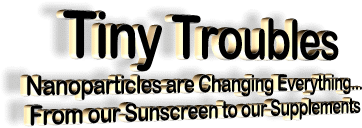|
Source: E Magazine July/August 2009 from MediaFreedomInternational Website
Over 600 products now on the market
contain nanoparticles so small that they may have dangerous
biological impacts yet to be determined. Nanoparticles could be
the asbestos of this century.
More specifically, studies conducted on
the negativities of nanotechnology are diminutive compared to those
conducted on the positive effects produced. Of $1.5 billion in
federal nano spending each year, only between 1% and 2.5% goes
towards studying environmental, health and safety risks.
Along with this, medical researchers are investigating ways to use nanomaterials to target tumors.
This would allow doctors to deliver
medication directly to cancer cells within the body, and leave the
healthy cells absolutely unharmed. Also, possible green tech
applications would make for cheaper, more efficient solar panels and
water filtration systems, energy-saving batteries and lighter
vehicles that ultimately use less fuel.
Much of the damage caused by asbestos
could have been avoided if the government had taken note of the
very present danger signs.
|
